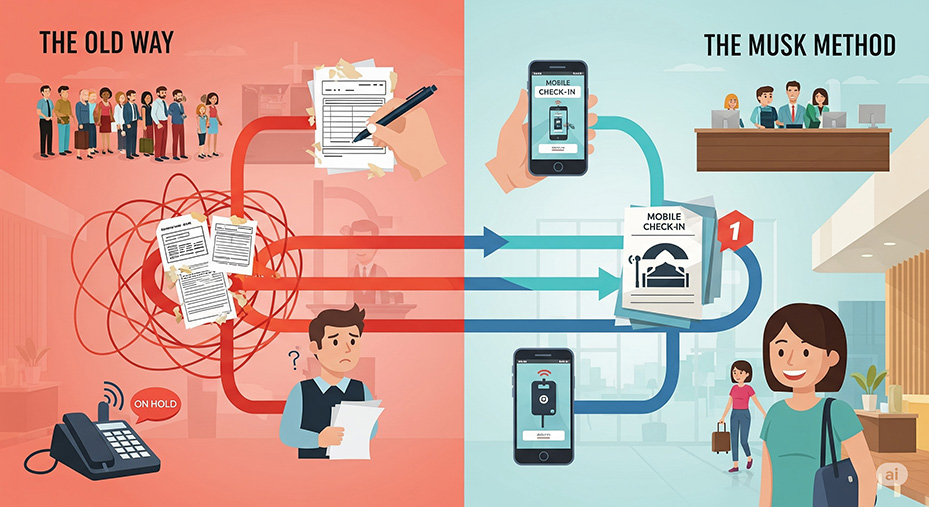
Love him or question him, there’s no denying that Elon Musk is one of the most disruptive figures of our time. While his public persona often sparks debate, if you separate the man from the method, you discover a compelling framework for innovation. This framework is a universal logic for deconstructing any process and rebuilding it to be dramatically better.
Elon Musk’s approach to any project is about relentlessly questioning the status quo and having the courage to tear things down to their essential components. It’s a mindset ideally suited for the hotel industry—an industry rich with tradition but ripe for transformation.
In this post, I will focus purely on the power of his five-step algorithm (question requirements, remove parts, simplify & optimize, accelerate cycles, and automate) and apply this exact process to the backbone of your business: the hotel guest journey. The goal is to move beyond minor tweaks and find transformative improvements that not only elevate guest satisfaction to new heights but also drive significant gains in efficiency and, ultimately, profitability. Let’s break down how to apply this to the five stages of the guest journey.
1. Attract: Getting on the Guest’s Radar
This stage is about marketing and first impressions. It’s often bloated with legacy strategies and assumptions.
- Question Requirements: Do you really need to be on every social media platform? Do you need to pay high commissions to every Online Travel Agency (OTA)? The fundamental requirement is to reach your ideal guest profile where they are actively looking. Question the assumption that more channels are always better.
- Remove Parts: Analyze your marketing channels. If a specific OTA consistently brings low-margin, high-complaint guests, have the courage to remove your listing. If you’re spending hours creating content for a social platform that generates zero bookings, delete that effort.
- Simplify & Optimize: Instead of a dozen complex promotions, create one or two simple, compelling offers for direct bookers. Focus your efforts on the 2-3 channels that deliver the highest return on investment. Simplify your brand message to its absolute core.
- Accelerate Cycles: Instead of running a three-month marketing campaign to see what works, run one-week A/B testing sprints on your ad copy, images, and offers. Get feedback from data fast so you can iterate quickly.
- Automate: Use software to automate social media posting on your core channels. Implement automated bidding strategies for your most effective digital ads.
2. Capture: Securing the Booking
This is the booking process itself—a common point of failure where friction kills conversions.
- Question Requirements: What information is absolutely essential to secure a booking? A name, an email, and a valid payment method. Do you need their home address, phone number, and guest title (Mr./Mrs.) right now? No. Question every single field on your booking form.
- Remove Parts: Delete every non-essential form field. A guest’s journey from selecting a room to confirmation should be brutally efficient. Remove pop-ups, unnecessary clicks, and confusing rate options. The goal is to eliminate anything that causes hesitation.
- Simplify & Optimize: Aim for a single-page checkout. Make the “Book Now” button the most prominent, obvious element on your website. Ensure your booking engine is lightning-fast, especially on mobile.
- Accelerate Cycles: Time how long it takes an average user to book a room on your site. If it’s more than 90 seconds, it’s too long. “If the timeline is long, it is wrong.” Shorten the path from landing page to “Thank You for Booking.”
- Automate: Use an AI-powered chatbot to instantly answer common questions that might stop a user from booking. Automate “abandoned cart” emails to recapture guests who drop off during the process.
3. Prepare: The Pre-Arrival Experience
This crucial period between booking and arrival sets the tone for the entire stay.
- Question Requirements: What does the guest truly need to know before they arrive? Directions, check-in time, and maybe an opportunity to enhance their stay. Do they need a five-page PDF of hotel policies? No.
- Remove Parts: Eliminate the long, generic, text-heavy confirmation email. Stop sending multiple, uncoordinated messages from different departments (e.g., spa, restaurant).
- Simplify & Optimize: Replace the dense email with a simple, scannable message (or even an SMS) with clear links for “Directions,” “Upgrade Your Stay,” or “Local Tips.” Offer a simple mobile pre-check-in to get formalities out of the way.
- Accelerate Cycles: How quickly can you confirm a guest’s request for an early check-in or a dinner reservation? The learning cycle here is about response time. Aim for near-instant confirmations, not “we’ll get back to you in 24 hours.”
- Automate: Fully automate the pre-arrival communication flow based on the number of days before arrival. Use your property management system (PMS) to automatically send offers for paid room upgrades when higher categories are available.
4. Deliver: The On-Property Stay
This is the core product: the stay itself. It’s often riddled with processes that exist “because we’ve always done it that way.”
- Question Requirements: What is the purpose of a front desk check-in? To verify identity, take payment, and issue a key. Can this be done without a physical queue? Absolutely. Question every single manual process your staff performs.
- Remove Parts: This is where the most radical improvements can be made. Delete the front desk queue. With mobile keys and pre-arrival payment, the traditional check-in process can be eliminated for many guests. Remove paper directories from rooms and replace them with a simple QR code. Don’t optimize the queue; delete it.
- Simplify & Optimize: Instead of forcing guests to call the front desk for everything, offer a simple guest messaging service (like WhatsApp) for all requests. Simplify your room service menu to high-quality, easy-to-prepare items to ensure speed and consistency.
- Accelerate Cycles: How long does it take to deliver an extra towel to a room? Time it. Then, figure out how to cut that time in half. The check-out should be instantaneous—an automatically emailed folio and an express drop box or mobile checkout button.
- Automate: Automate the final bill generation and emailing at check-out. Use smart-room technology to automate lighting and temperature settings for energy efficiency and guest comfort.
5. Review: The Post-Stay Follow-Up
This final stage is your opportunity to gather feedback for improvement and generate powerful social proof.
- Question Requirements: Why do we ask for feedback? To learn what to fix and to encourage public reviews. Do we need a 30-question survey to do that? Absolutely not.
- Remove Parts: Delete the long, boring feedback survey that has a 1% completion rate. Stop sending generic “Please review us” emails that get ignored.
- Simplify & Optimize: Send a single, simple, well-timed email or SMS. Ask one question: “How likely are you to recommend us? (1-10)”.
- If the score is high (9-10), the following screen says: “Great! We’d love it if you shared your experience on Google” with a direct link.
- If the score is low, the following screen says: “We’re sorry we fell short. Please tell us what we can do better.” This funnels positive reviews to public sites and captures negative feedback internally so you can fix it.
- Accelerate Cycles: Test the timing of your feedback request. Do you get a better response rate 3 hours after checkout or 24 hours later? Find the optimal window and shrink the time it takes for you to learn from guest feedback.
- Automate: The entire feedback funnel—from the initial ask to the follow-up prompt—should be 100% automated through your PMS or CRM. Automatically flag negative feedback for a personal follow-up from a manager.
Conclusion: Building the Hotel of the Future
Applying Elon Musk’s five-step algorithm is more than a simple operational exercise; it’s a paradigm shift. It’s about moving from “this is how we do things” to “is this thing even necessary?” The most profound insight is that true innovation often comes not from adding more features, but from ruthlessly removing friction.
By questioning every requirement, deleting unnecessary processes, and simplifying what remains, you’re not just making your hotel more efficient. You are designing a guest experience that is so seamless, so intuitive, and so respectful of your guest’s time that it becomes a defining feature of your brand. In today’s market, a frictionless experience is the ultimate luxury. Don’t just optimize the hotel of the past; start building the hotel of the future.
Key Takeaways for the Modern Hotelier
- Question Everything: Your most powerful tool is the word “Why?”. Challenge every legacy process, every form field, and every step your staff or guests have to take. If a requirement doesn’t serve a fundamental purpose, it’s a candidate for elimination.
- Be a Ruthless Editor: The bravest move is to delete. The best part is no part. Don’t just shorten the check-in queue; question if it should exist at all. Don’t just simplify the survey; ask if a simple one-question prompt is better.
- Simplicity is the New Luxury: Every step you remove, every click you save, every moment of confusion you prevent contributes directly to guest satisfaction. A simple, intuitive process feels like premium service.
- Accelerate Your Learning: Don’t wait months to see if a change worked. Run small, fast experiments. A/B test your booking engine, time your room service delivery, and get feedback loops running in days, not quarters.
- Automate Last, Not First: Automation is a powerful tool, but only after you have questioned, removed, and simplified. Automating a broken or unnecessary process makes you do the wrong thing faster.
Your Mission: Start with One Thing
This can feel overwhelming, so let’s make it simple. Your challenge for this week is not to redesign your entire operation. The goal is to pick one single point of friction and attack it with this framework.
While your guests are enjoying the destination, gather your team for 15 minutes and choose one of these areas: the booking form, the pre-arrival email, or the check-out process.
Ask the two critical questions:
- What is the absolute minimum we need to accomplish here?
- What is one step, field, or action we can completely eliminate right now?
Start there. True transformation begins with a single, bold decision to delete something that shouldn’t exist. Make your guests’ journey simpler today.






